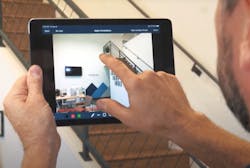Getting past the spreadsheet: new tool streamlines security design for campuses
For years, integrators and customers working on school security upgrades and maintenance have relied on paper floorplans, hand-written mark-ups and pictures on cell phones.
In 2014, two operational technology experts – Chris Hugman and Maureen Carlson -- set out to change this when they founded System Surveyor, a secure, cloud-based platform with a mobile tablet app that houses a campus’ physical security, IT and technology assets in one place as a digital map.
System Surveyor has since helped schools like New York University, Cal State Fullerton, University of Utah, Ysleta School District and Atlanta Public Schools streamline their security solutions as they work to improve school safety.
Carlson, Vice President for Growth at System Surveyor, and Hector Guzman, a Solutions Architect at Idaho-based systems integrator Ednetics, spoke with SecurityInfoWatch about the technology’s genesis and how it can improve the survey process at school districts.
SIW: Tell us about the founding and history of System Survey and the concept that led to this technology being created.
Carlson: Chris Hugman is the domain founder and comes from deep experience with system integration over the last 20 years. He was out running the operations team and they had a sales part of the organization, and they were serving a huge education customer in Texas. He had a big customer call him and say, ‘Chris, can you help me understand why, when your techs come out here, they’re asking me where these certain cameras are?’
Chris didn’t have a digital map of where they were located, and he didn’t like that feeling. At that time, the tablet was coming on strong. It has a camera in it, but there's never been an app built specifically for physical security. He did it while he was working at the integrator, but there's no intellectual property ownership there. He told them and said, ‘Hey, I want to build this software.’
I came from the software field but was working in physical security for a manufacturer. Next thing you know, after we launched, people would say, ‘I love this. It's changing the way that I do business.’ Here we are in 2023 and we have several thousand users active every single day.
SIW: As you come on-site as an integrator, Hector, how far behind are most school districts in documenting and maintaining their security assets?
Guzman: A lot of them are at least three to four years behind because audits don't get done unless they’re going out to a bond. There's a huge audit, somebody would come in and start and start designing and haphazardly doing some management.
Typically, nobody’s keeping up if a camera changes models or door hardware gets changed.
For an integrator, having a clear understanding on the software of what each of the icons means makes it easier to have lifecycle conversations with anybody, especially if you're going out and looking to add things in the future. Schools have long sales cycles. When they want to do something, it usually takes a year to get something. It's nice having all your designs and collaboration with System Surveyor working during that whole time.
SIW: What are some of the biggest challenges you’ve seen with the way security systems are designed and documented?
Guzman: The biggest thing is not having the data there to support what they need, whether they're adding cameras, adding doors, adding any sort of physical security items. They don't know how long those cameras have been there, or when the last time that door strike was serviced. No one's documenting that in an intelligent way. And if they are, they're doing it with a pretty basic spreadsheet that doesn’t give you alerts or tell you what kind of hardware it is. With System Surveyor it’s easier to hop in there and anybody can start documenting the data to build a budget in the future.
Cabling is a big thing right now. Cabling specs have kind of changed for power over ethernet (POE), but everyone thinks as they can plug it in and start using it, it works, right? But that might be a CAT 5 cable that can't do lighting, or a door strike.
SIW: What are the advantages of streamlining the design process from the end-user’s standpoint?
Carlson: The integrator is our primary ideal customer, and Hector’s company is exactly to whom we sell. But end users are buying it from us, too. Almost every end user -- let's say it's a K-12 or campus security – has someone responsible for the campus, who we call stakeholders. They want an accurate design as early as possible because they've got to ask for money. And when the design is haphazardly put together it's tough on them. And then they might be trying to get multiple bids.
When an integrator has a tool that allows them to communicate and collaborate with the end user, the streamlining makes them more of a partner, as most campus security people don’t have a lot of resources.
The way System Surveyor presents information makes it easy to understand for stakeholders, whether they’re principals or superintendents. If a question comes up, most integrators must go and visually find where the cameras are. But System Surveyor color coordinates those on the map. They click on the icon and get all the information that’s relevant to whatever situation they’re talking through with the customer.
SIW: From an integrator’s point of view, how much more efficient is this approach compared to what you were doing?
Guzman: We used to use Bluebeam, which is used by construction firms. With System Surveyor I’m reducing the basis-of-design process by two to three weeks because you can be onsite taking pictures and documenting everything right there. With Bluebeam you’re taking pictures and notes and hopefully, when you reach the parking lot you have good enough internet to upload and things aren’t lost.
Carlson: In the past, things were filed away on CAD or PDFs, but a PDF is immediately a frozen document. Beyond just helping the integrator’s sales team get those nice-looking proposals, System Surveyor becomes a digital system of record. It’s not like ‘Hey, I want to buy 15 cameras, you install them and bye guys.’ What you can see with integrators like Hector is it's like this long-term relationship. The end user knows the mean time to failure or inspection, for example.
By the way, this isn't just Hector's software. He can pull a guest user in so they’re not emailing PDFs and things are getting lost. It’s about getting in and saying, ‘Hey, a picture's worth a thousand words. What if you could look at the picture of what we are trying to accomplish?’
Guzman: If somebody makes a change, or if the tech goes in and replaces something, everyone knows that that's now a Hanwha camera and here's the Mac address, here's the IP address and here’s when it was installed. Then you can start building your schedule of maintenance off that.
SIW: You recently released version 2.0 of this software. What are some of the upgrades?
Carlson: About 18 months ago we had to make a tough decision to rewrite the software because the infrastructure wasn’t multi-platform. We have a lot of customers who are really purist on iPad and others are purist on Android, or even now with Microsoft. We got multi-platform based on one code, and to our customers, it means a lot because someone could choose Android and another person could choose iPad. And 2.0 is a lot faster and the user interface is much cleaner.
SIW: You have several manufacturer partners, including i-Pro, Verkada and Hanwha Vision. Describe your relationship with them.
Carlson: I came from a manufacturer, and I remember thinking, ‘There’s kind of a three-legged stool here, right?’ There are system integrators, the end users and the manufacturers.
Hanwha was the first one who understood this opportunity. There's no money that changes hands between System Surveyor and the manufacturers. They all provide their catalog, it's open public-source information, they pull it down in a format and you can put it into System Surveyor and automatically drag and drop.
We’ve got video surveillance fairly tied up, but increasingly we’re broadening into other areas. What about lighting and video surveillance? What about sound? No one manufacturer has gotten this all figured out. I mean, they would like to probably say that they do, but it's a system made up of cabling and lots of elements. It would be interesting to see more come along in access control.



